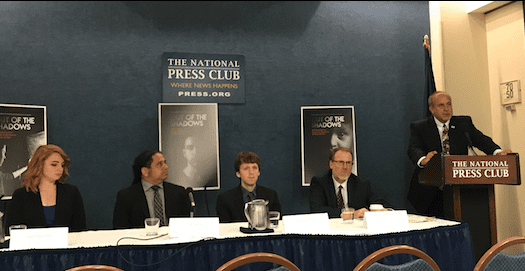Casting New Light on Sexual Exploitation of Men and Boys

The term ‘sexual exploitation’ tends to conjure notions of young girls being taken, a la the Liam Neeson movie franchise, into sexual slavery. This sort of sexual exploitation is indeed a massive problem worldwide, including here in the United States. And while there is still much work to do to end the exploitation of women, there is plenty of global awareness about it.
On September 8, the National Center on Sexual Exploitation (NCOSE) held an inaugural symposium to shine light on a lesser-known aspect of sexual exploitation: that of boys and men. While this focus may seem unusual, if not obfuscating, the speakers compiled by NCOSE made a compelling case that this problem does not discriminate based on sex.
In a press conference preceding the national symposium Thursday morning, Tom Jones of the H.O.P.E. project gave an overview of his organization’s work. Jones, himself a survivor of sex trafficking, uses his story to highlight the epidemic of sexual exploitation of boys and men. “When you mention sex trafficking it’s not normally men and boys who you think of,” Jones said, “But my story is representative of so many men in America.” Jones created the H.O.P.E. project to “establish a fellowship of peer support for [other] men who survived.”
Echoing Jones’s sentiments was Kevin Malone of the U.S. Institute Against Human Trafficking. Malone, who previously enjoyed a long career in baseball as both a player and executive, gave an impassioned explanation of his decision to get involved in combating issues of human trafficking. “I’m outraged,” declared Malone, “Why are we as Americans not outraged about sex slavery of our boys and girls?”
While the exploitation highlighted by Jones and Malone are blatant cases of abuse, two other speakers made the case against a more insidious type of sexual exploitation: the scourge of pornography. Joseph Prud’homme, director of the Institute for Religion, Politics, and Culture at Washington College, emphasized the link between porn consumption and “the new cultural norm of the sexual commodification of men.”
“Twenty percent of women under the age of 25 use porn at least once per week,” said Prud’homme, “which is only slightly less than men.” This commodification has offline consequences, as well: “Forty percent of all strip clubs now have men performers,” a rate that has dramatically increased in recent years. All of this has led to an unhealthy concern with physical appearance among young men, so much so that “men in their 20s and 30s…are increasingly prioritizing appearance over health, family, relationships, and professional success.”
Critics of Prud’homme’s claims may charge that increased pornography use among women and men performers at strip clubs hardly rise to the level of sexual exploitation. In fact, many have argued for continued pornification of the culture as healthy, “sex-positive” progress against old-fashioned mores. The data, however, don’t exactly support this prescription.
Alexander Rhodes, founder of the pornography recovery website NoFap, pushed back emphatically against the “sex-negative” label that occasionally dogs his work during his presentation at the NCOSE symposium. “The Daily Mail called my website an anti-sex group, which is blatantly dishonest,” Rhodes retorted. “Many people who want to quit porn are doing so in pursuit of better sex and more of it.” Rhodes finds that the users of his site have often experienced a decrease in sexual desire as a result of porn usage, and “it’s hard to be more sex-negative than not wanting to have sex and instead preferring pixels on a computer screen.”
The real exploitative power of pornography stems from its ubiquity and addictiveness. Rhodes, citing a 2014 study, revealed that,“48.7 percent of college-aged students had porn exposure before the age of 13, and only 10.9 percent [of those students] no longer use porn.” Indeed, Rhodes often begins his work by encouraging users of his site to “simply take a quick break [from porn].” Their inability to do so even for a short period of time allows them to realize the power of their addiction.
Much of the addictive power of pornography is due to an increasingly lowering age of first exposure. Through his work, Rhodes has found that many boys are now “consuming porn long before they have their first kiss.” To Prud’homme, the childhood-aged introduction to porn demands closing what he calls the “empathy gap.”
“We need to understand that our boys are often victims of our pornified culture. [Porn] is coming after them at the earliest of ages through pop-ups, through deceptive websites that lead you to the material so a nine, ten, eleven year old boy may enter into the world of pornography.”
The debate over pornography’s exploitative qualities will continue. But for NCOSE’s Haley Halverson, the connection is clear. “Research shows that when someone is being objectified, the objectifier views the objectified person as less than a person, without an individual mind and undeserving of moral treatment. That alone is alarming and feeds into rape myths,” Halverson claimed. “But worse, pornography usage is linked to addictions or compulsive use, increased rates of sexual violence, increased likelihood of child-on-child sexual abuse and it is used as a tool in the recruitment of children trafficked for sex, just to name a few alarming connections.”
Emile Doak is director of events & outreach at The American Conservative.
Comments